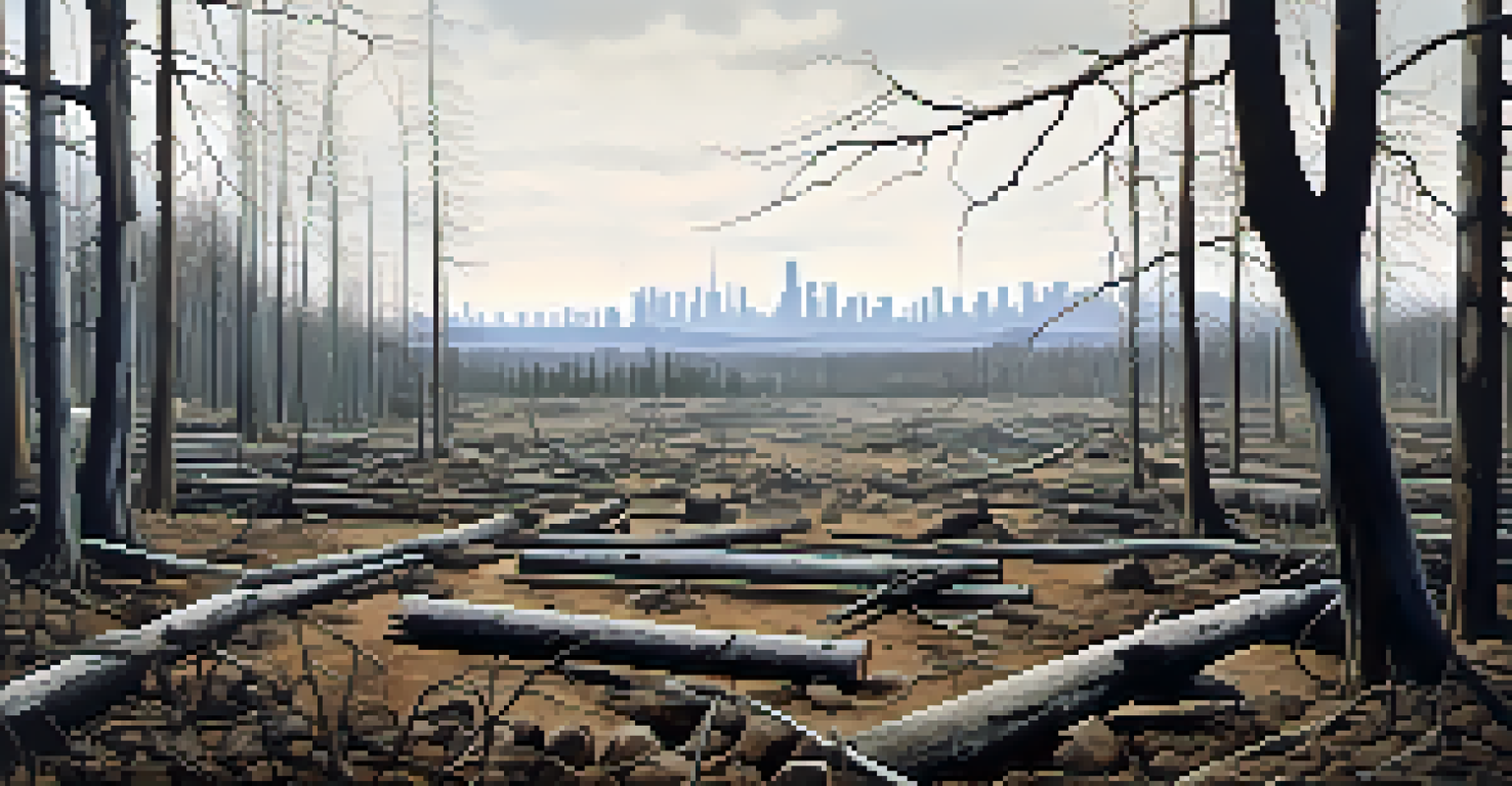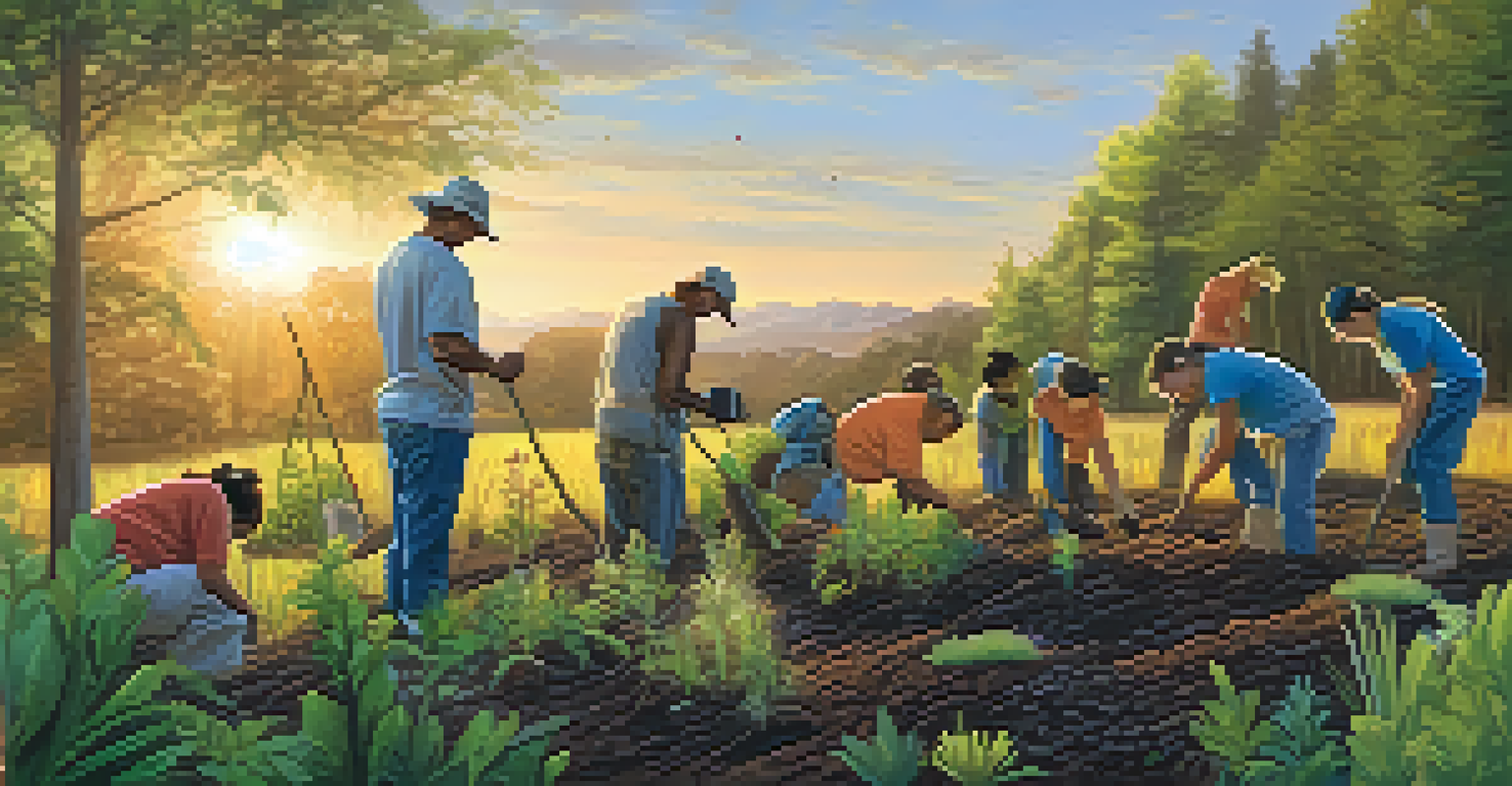Deforestation Effects on Native vs. Invasive Plant Species

Understanding Deforestation and Its Causes
Deforestation refers to the large-scale removal of trees and forests, often for agriculture, urban development, or logging. This practice can have profound effects on ecosystems, especially in areas rich in biodiversity. The reasons behind deforestation are complex, involving economic pressures, land-use changes, and sometimes the demand for resources.
The clearest way into the Universe is through a forest wilderness.
As forests are cleared, the natural habitat for many species diminishes, leading to a decline in native plant populations. These native species are adapted to their specific environments and play crucial roles in maintaining ecological balance. Understanding the causes of deforestation helps highlight the urgency of addressing its impacts.
Additionally, climate change and human activity exacerbate the problem, leading to further habitat loss. By recognizing these causes, we can begin to explore the effects on both native and invasive plant species that follow.
Effects of Deforestation on Native Plant Species
Native plants are those species that naturally occur in a particular region and have evolved to thrive in its specific conditions. When deforestation occurs, these plants face immediate threats, including habitat destruction and competition from invasive species. Their specialized relationships with local fauna and other flora can be disrupted, leading to potential extinction.

Moreover, the loss of native plants can have cascading effects on the entire ecosystem. For instance, many native species provide food and shelter for local wildlife, which can then suffer from the decline in plant populations. This disruption can alter pollination patterns and seed dispersal, further diminishing native flora.
Deforestation Threatens Native Plants
The large-scale removal of forests disrupts ecosystems, leading to habitat loss and potential extinction of native plant species.
In summary, deforestation not only directly harms native plants but also destabilizes the wider ecosystem. Protecting these species is crucial for maintaining biodiversity and ecological health.
The Rise of Invasive Plant Species Post-Deforestation
Invasive plant species are non-native species that thrive in new environments, often outcompeting local flora. After deforestation, the sudden availability of resources creates ideal conditions for these invasives to flourish. They can spread rapidly, taking advantage of the disturbed soil and sunlight that were previously shaded by trees.
In nature's economy, the currency is not money, it is life.
These invasive species can significantly alter the landscape and function of ecosystems. For example, they often lack natural predators in their new environment, allowing them to dominate and further suppress native species. This leads to a decrease in biodiversity, as native plants are pushed out of their habitats.
Understanding the dynamics between invasive species and deforestation helps underscore the need for careful land management. By addressing invasive species, we can support the recovery of native plant populations and restore ecological balance.
The Role of Climate Change in Deforestation Effects
Climate change acts as a catalyst for the effects of deforestation, intensifying environmental stressors. For instance, rising temperatures and altered precipitation patterns can make it more challenging for native plants to survive. As deforestation reduces shade and moisture, the local climate can become even less hospitable for these species.
Invasive species often adapt more quickly to changing conditions, giving them an advantage over native plants. This leads to a further decline in the resilience of native species, ultimately affecting the entire ecosystem. The interplay between climate change and deforestation creates a cycle that can be difficult to break.
Invasive Species Flourish Post-Clearing
After deforestation, invasive plant species take advantage of disturbed environments, outcompeting native flora and altering ecosystems.
Addressing climate change alongside deforestation is essential for protecting native plant species. Strategies that consider both factors can help mitigate the impacts on ecosystems.
The Importance of Biodiversity in Ecosystem Health
Biodiversity refers to the variety of life in a particular habitat or ecosystem, including the different species of plants and animals. High biodiversity is crucial for ecosystem resilience, allowing it to withstand and recover from changes. Native plants contribute to this diversity, offering unique functions and services that benefit the environment.
When native species are lost due to deforestation, the overall health of the ecosystem can decline. For example, native plants often support local wildlife, provide erosion control, and improve soil health. The loss of these species can lead to weaker ecosystems that are less able to support life.
Promoting biodiversity is not just about protecting native species; it’s also about creating a balanced ecosystem. Efforts aimed at conservation can help restore native plant populations and enhance the overall health of the environment.
Conservation Efforts to Protect Native Species
Conservation efforts play a critical role in mitigating the effects of deforestation on native plant species. These initiatives often include habitat restoration, where native plants are replanted in areas that have been cleared. Such projects can help re-establish the ecological balance and support local wildlife once again.
In addition, educating communities about the importance of native species fosters a sense of stewardship. When people understand how deforestation affects their local environment, they may be more inclined to participate in conservation efforts. This grassroots approach can lead to significant local action and support.
Biodiversity is Key to Ecosystem Health
Maintaining high biodiversity, particularly through the protection of native species, is crucial for the resilience and overall health of ecosystems.
Furthermore, policies that promote sustainable land use can help protect remaining forests. By integrating conservation into development plans, we can safeguard native plant species for future generations.
Strategies to Combat Invasive Species
Combating invasive plant species is essential for protecting native ecosystems affected by deforestation. Various strategies exist, including physical removal, chemical treatments, and promoting the growth of native species to outcompete invasives. Each method has its pros and cons, and often a combination of approaches works best.
Public awareness campaigns can also be instrumental in preventing the spread of invasive species. Educating landowners and the public about the risks associated with invasive plants can empower them to take action. Simple steps, like cleaning footwear and equipment before entering natural areas, can significantly reduce the spread.

Ultimately, addressing invasive species requires a collaborative effort among communities and conservation organizations. Together, we can work towards restoring native plant populations and enhancing ecosystem health.
The Path Forward for Native and Invasive Species
The ongoing challenge of balancing native and invasive plant species in the wake of deforestation calls for a multifaceted approach. By prioritizing conservation and restoration efforts, we can protect native species and restore ecosystems. This involves understanding the intricate relationships between species and the environments they inhabit.
As we move forward, integrating sustainable practices in forestry, agriculture, and urban planning will be key. By considering how our actions impact both native and invasive species, we can create more resilient landscapes. This proactive approach not only benefits biodiversity but also enhances the overall health of our planet.
In conclusion, addressing the effects of deforestation on native and invasive plant species is crucial for ecological balance. By working together, we can forge a path toward a more sustainable future where both native and invasive species are managed effectively.